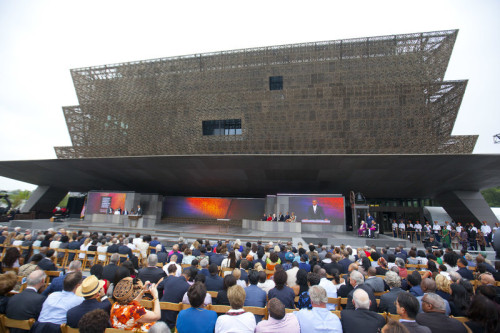September 24, 2016

President Barack Obama speaks during the dedication ceremony for the Smithsonian Museum of African American History and Culture on the National Mall in Washington.
Pablo Martinez Monsivais/AP
More than 100 years after it was originally proposed, the Smithsonian National Museum of African American History and Culture is opening its doors in Washington, D.C.
In President Obama’s remarks at the dedication ceremony, he said this museum shines a light on stories that are often overlooked in the history books.
“This national museum helps to tell a richer and fuller story of who we are,” Obama said. “It helps us better understand the lives of yes, the president, but also the slave. The industrialist but also the porter. The keeper of the status quo but also the activist seeking to overthrow that status quo.”

President Barack Obama speaks during the opening ceremony of the Smithsonian National Museum of African American History and Culture on the National Mall in Washington on Saturday.
Manuel Balce Ceneta/AP
This museum, Obama says, provides “context for the debates of our time.” He says it’s also a “place to understand how protest and love of country don’t merely coexist but inform each other”:
“How men can proudly win the Gold for their country but still insist on raising a black-gloved fist. How we can wear an ‘I can’t breathe’ t-shirt but still grieve for fallen police officers. Here’s the American where the razor-sharp uniform of the Chairman of the Joint Chief of Staff, belongs alongside the cape of the godfather of soul.”

Ida Mae Hughes, 86, of Kansas City, Mo., raises her hands as President Barack Obama arrives at the dedication and opening ceremony of the Smithsonian’s National Museum of African American History and Culture.
Cliff Owen/AP
The museum is opening amid a three-day celebration, including “musical performances, dance, spoken word, oral history activities and two evening concerts.” It officially opened to the public at 1 p.m. today – and passes for opening weekend are sold out.
It has been in the works for more than a century – as NPR’s Tanya Ballard Brown reported, it was “first proposed in 1915 by black veterans of the Civil War.” She walked us through the many steps between that initial proposal and today’s dedication ceremony here.
The museum is organized so that visitors experience a journey from darkness into light, as Tanya explained:
“The majority of the exhibition space is underground. On the bottom level, museum-goers will find themselves in literal and metaphorical darkness: slavery. Then, as they ascend, visitors move through exhibits exploring the Jim Crow era and the civil rights movement, until finally reaching light and joy — above-ground galleries devoted to culture, music, dance, literature.”
And as NPR’s Elizabeth Blair reported, “The collection of some 35,000 artifacts from around the world includes a slave cabin, Harriet Tubman’s hymnal and Michael Jackson’s fedora.“
Museum director Lonnie Bunch said during the dedication ceremony that the museum is a “clarion call to remember”:
“To remember not just the well-known, but also those famous only to their families, whose lives in quiet ways shaped this nation. We remember so we can ponder the pain of slavery, segregation and second-class citizenry, but we also find the resiliency, the faith, the hope, the joy that is so much a part of the African-American community.”



